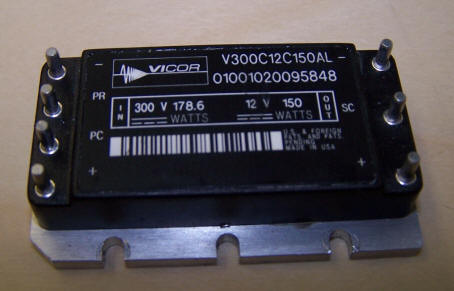RIKLBLOG
|
| Tomorrow |
| 10 August 2006 |
| Yesterday |
| Index |
| Eventide |
| SETI League |
| PriUPS Project |
| Bonus! |
| Contact |
Living Vicoriously
When I saw the new equipment previews from the Dayton Hamvention in the ARRL letter, I thought it might be fun to run a full gallon from the mobile. Elecraft, it seems is about to offer a 1.5kW semiconductor amplifier, and it occurred to me that it might very well run on a voltage that I could easily generate either with my 48VDC Cherokee supplies, or, possibly, it already has a switcher that will run on the nominal 220VDC from the Prius. So I emailed Elecraft, and while I was waiting for the answer I started considering the matter of the low power transceiver that would drive this amplifier. The Prius has a somewhat anemic 12V system, which is recharged from the HV traction battery through a downconverter. I didn't want to heavily load this system, so I tried to find an appropriate power supply that would convert the 220V to 12V. I saw these little Vicor modules on eBay and decided that maybe I could run the transceiver on that. (The 300V in the picture is its nominal rating - it's quite content to run at 200V or even below.)
As an experiment, I hooked up the module HV input to the traction battery through the Anderson connector and a small fuse. I then connected the output terminals directly to the transceiver. It worked instantly! However, as you know, mobile equipment really is designed to work on about 13-14V, which is the nominal voltage of an automotive electrical system while the alternator is charging it. In order to raise the voltage of the Vicor module to its maximum and desirable 13.2V, I calculated that I needed a 96kOhm resistor to connect between SC and the + terminal. I just happened to have the right value, made the connection, and measured the voltage. 12.1V. What's wrong here, I wondered? It should have been 13.2! Thinking I might have miscalculated, I got a 47k resistor and connected it between SC and +. Instant module death! The voltage went down to 2.4 volts and stayed there. Whoops. I must have tripped the OVP somehow. So I removed primary power from the module, waited a few seconds, and turned it back on. Still dead! I figured at this point I was scrod, emailed the manufacturer's tech support, and called it quits until I heard back.
On Monday I had speaks with Vicor, and they were as puzzled as I was: Putting a 47k resistor on a high power module could, at most, put a 200 microamp current where it didn't belong, right? But the helpful tech support guy asked me how long I had waited before reapplying power. I figured a few seconds, maybe as much as a minute. He told me "Try it again after waiting 15 minutes." I said "OK."
Sure enough, when I tried it again, it was working perfectly. At that point, I measured the 96k resistor and found it to be 960k. It had been mislabeled! Suddenly it came all clear: Of course the voltage only went up to 12.1. The trim resistor value was 10 times too high! And when I connected the 47k resistor, of course the module died. Just as I had suspected, I had tripped the OVP. I then used a 100k resistor between SC and +, and, sure enough the output voltage went to a little under 13.2V and all was good in my Vicorious world. I'll now be able to use one or more of these modules to power my transceiver. Hopefully I'll hear from Elecraft soon and find out if the rest of my scheme can be realized.
There was still one remaining puzzle, though. I emailed Mr. Tech Support with my results, told him the module and the calculations were OK, and asked why the module didn't come right back up after I removed and reconnected primary power. Do you know what he told me? Ready? It seems that (deliberately) the overvoltage protection circuit has a capacitor with no discharge path to ground! The Final Mystery explained!
OMG! What do you mean, my translator didn't come in today? This is the only blogitem I have ready and it's written in Nerd... He's not feeling well? He doesn't have to feel well, he just has to translate it into English. Can't, huh? Alright, we'll go with it as it is. I hope he gets better soon or it's back to pastry repair.
| © 2006 |
| Richard Factor |
